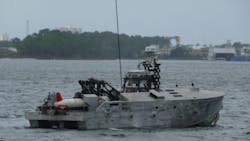Navy MAGNUSS project blends superconductor magnet and very high electrical currents for counter-mine warfare
ARLINGTON, Va. – U.S. Navy researchers are preparing to approach industry for counter-mine technologies for the future Mine Countermeasures Unmanned Surface Vehicle (MCM-USV) -- a long-endurance, semi-autonomous, diesel-powered boat for counter-mine operations.
Officials of the Office of Naval Research (ONR) in Arlington, Va., issued a special notice (N00014-21-S-SN12) last Wednesday for the Magnetic and Acoustic Generation Next Unmanned Superconducting Sweep (MAGNUSS) project.
The idea is to develop an advanced minesweeping payload composed of a high-temperature superconducting magnetic source with an advanced acoustic generator for the MCM-USV. The MCM USV program use several payload delivery systems to include the minesweeping payload delivery system, minehunting payload delivery system, and future payload delivery systems for mine neutralization.
The Navy has been moving the mine countermeasures mission to the Littoral Combat Ship (LCS) as a suite of mission modules like the MCM-USV as a deployable system on the LCS to complete the minesweeping mission. The Office of Naval Research, meanwhile, has been developing an advanced closed-loop minesweeping system using an high-temperature superconductor magnet coupled with an acoustic source to generate underwater acoustic energy.
Related: New ship takes lead in counter-mine and anti-submarine warfare
The advantage of using an high-temperature superconductor magnet is the ability to run at very high electrical currents with near-zero resistance, which can sweep magnetic influence mines when coupled to an acoustic generator.
In addition to the recent advancement of high-temperature superconductor magnets to provide a non-towed magnetic source, Navy researchers want a non-towed, underwater acoustic source with low-drag as an alternative to a legacy acoustic generator that still enables additional benefits to the non-towed magnetic source.
The modularity of the high-temperature superconductor magnet and acoustic generator potentially could be deployed on any craft of opportunity -- not just aboard the MCM-USV.
This electromagnetic warfare project seeks to integrate the high-temperature superconductor magnet, acoustic generator systems, and command and control for deployment onboard a small craft like the MCM-USV.
Related: Navy ramping up fleet and technologies to face new threats
From industry, Navy researchers want proposals on integrating a high-temperature superconductor magnet with a non-towed low-drag underwater acoustic generator as a single payload deployable aboard the MCM-USV.
The effort will procure a high-temperature superconductor magnet and an acoustic generator; integrate the mechanical, electrical, and command and controls (C2) systems of the two systems with each other; and integrate the complete payload with the MCM-USV and its hull for demonstration.
Companies interested should email proposals no later than 17 Dec. 2021 to [email protected]. Email questions or concerns to the Navy's Brian Almquist at [email protected]. More information is online at https://sam.gov/opp/3874efee2de042bca3fa067616c83ae7/view.
About the Author
John Keller
Editor-in-Chief
John Keller is the Editor-in-Chief, Military & Aerospace Electronics Magazine--provides extensive coverage and analysis of enabling electronics and optoelectronic technologies in military, space and commercial aviation applications. John has been a member of the Military & Aerospace Electronics staff since 1989 and chief editor since 1995.
